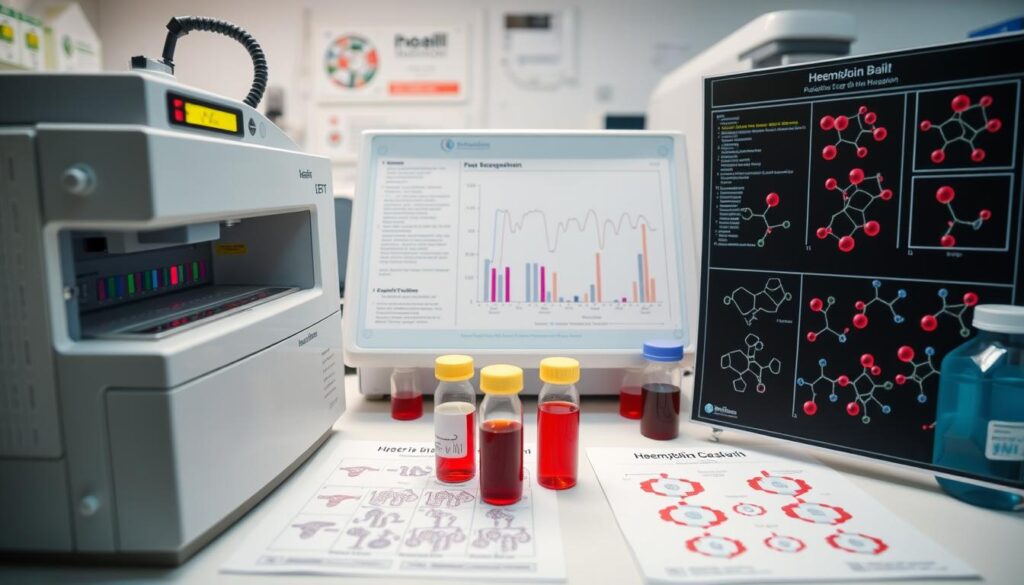About 5% of the world’s population carries a gene that can cause haemoglobinopathies. These are genetic diseases that affect how red blood cells carry oxygen. This leads to different blood disorders.
Haemoglobinopathies are a big health issue, affecting millions globally. They happen when genes for hemoglobin are mutated. This results in abnormal hemoglobin and health problems like anemia and jaundice.

These diseases can greatly affect a person’s life. Knowing about the types, causes, and treatments is key. It helps manage and care for these conditions effectively.
Key Takeaways
- Haemoglobinopathies are a group of genetic diseases that affect hemoglobin production.
- These diseases can lead to various blood disorders and health problems.
- Haemoglobinopathies are caused by mutations in the genes that code for hemoglobin.
- Understanding the different types of haemoglobinopathies is crucial for effective management and care.
- Treatment options for haemoglobinopathies depend on the specific type and severity of the disease.
- Genetic counseling and testing can help identify individuals at risk of developing haemoglobinopathies.
Understanding Haemoglobinopathies: A Comprehensive Overview
Haemoglobinopathies are genetic disorders that affect hemoglobin production in red blood cells. These disorders can cause health issues like anemia and jaundice. They also increase the risk of infections. The most common types are thalassemia and sickle cell disease.
Haemoglobinopathies are divided into thalassemia and sickle cell disease. Thalassemia affects beta-globin chains, while sickle cell disease affects alpha-globin chains. Both can be severe if not treated early, making early diagnosis and treatment key.
Definition and Basic Concepts
Haemoglobinopathies result from gene mutations that affect hemoglobin production. This leads to red blood cells that can’t carry oxygen well. Knowing about haemoglobinopathies is vital for finding effective treatments.
Impact on Blood Function
Hemoglobin disorders like thalassemia and sickle cell disease harm blood function. Affected red blood cells may break down easily, causing anemia. It’s important to understand how haemoglobinopathies affect blood to develop good treatment plans.
Global Prevalence and Distribution
Haemoglobinopathies are a big public health issue, affecting over 300,000 births yearly. Sickle cell disease and thalassemia are the most common, impacting millions globally. Knowing the global spread helps in creating effective prevention and treatment plans.
The Role of Hemoglobin in Human Health
Hemoglobin is a protein found in red blood cells. It carries oxygen to various parts of the body. This protein is key to keeping red blood cells healthy. They are vital for delivering oxygen to tissues and organs.
The role of hemoglobin is clear in its oxygen-carrying function. It moves oxygen from the lungs to the body’s tissues and organs. This is crucial for keeping tissues and organs healthy. Here are some important facts about hemoglobin and red blood cells:
- Hemoglobin is produced in the bone marrow.
- It is made up of two alpha-globin chains and two beta-globin chains.
- Red blood cells live for about 120 days.
In summary, hemoglobin is a vital protein in red blood cells. It plays a key role in human health. Its job of carrying oxygen is essential for healthy tissues and organs.
Common Types of Haemoglobinopathies
Haemoglobinopathies are inherited disorders that affect the production of hemoglobin. This protein is crucial for carrying oxygen to the body’s tissues. These genetic diseases can cause health issues like anemia, jaundice, and a higher risk of infections. Sickle cell disease and thalassemia are two common types.
These conditions result from mutations in genes that code for hemoglobin. Sickle cell disease impacts the alpha-globin chains, while thalassemia affects the beta-globin chains. Other types include hemoglobin C disease and hemoglobin E disease.
Types of Haemoglobinopathies
- Sickle Cell Disease: a type of haemoglobinopathy that affects the production of the alpha-globin chains of hemoglobin
- Thalassemia: a type of haemoglobinopathy that affects the production of the beta-globin chains of hemoglobin
- Hemoglobin C Disease: a type of haemoglobinopathy that affects the production of hemoglobin
- Hemoglobin E Disease: a type of haemoglobinopathy that affects the production of hemoglobin
Knowing the different types of haemoglobinopathies is key for diagnosis and treatment. These disorders can greatly affect a person’s life. Early diagnosis and treatment can help manage symptoms and prevent complications.
It’s important to remember that haemoglobinopathies are genetic diseases passed down through generations. If your family has a history of these disorders, talk to a healthcare professional. Discuss your risk and options for genetic testing.
Genetic Factors and Inheritance Patterns
Haemoglobinopathies are genetic diseases passed down in an autosomal recessive pattern. This means a person needs two copies of the mutated gene, one from each parent, to have the condition. Knowing how these diseases are inherited helps in finding treatments and ways to prevent them.
The genes involved in haemoglobinopathies are complex. These inherited disorders happen when genes for hemoglobin mutate. This leads to abnormal hemoglobin production. Sickle cell disease and thalassemia are examples of these conditions.
Here are some key points about the genetic factors and inheritance patterns of haemoglobinopathies:
- Haemoglobinopathies are inherited in an autosomal recessive pattern.
- A person must inherit two copies of the mutated gene to develop the condition.
- The genetic factors that contribute to the development of haemoglobinopathies are complex and involve multiple genes.
Understanding the genetics of haemoglobinopathies helps doctors diagnose and treat these inherited disorders. They can also give genetic counseling to families affected by these diseases.
| Type of Haemoglobinopathy | Genetic Cause | Inheritance Pattern |
|---|---|---|
| Sickle Cell Disease | Mutation in the HBB gene | Autosomal Recessive |
| Thalassemia | Mutation in the HBA1/2 or HBB gene | Autosomal Recessive |
Clinical Manifestations and Symptoms
Haemoglobinopathies can lead to various symptoms, such as anemia, jaundice, and a higher risk of infections. It’s key to understand these symptoms to manage and treat them effectively. Anemia is a major concern, causing fatigue, weakness, and shortness of breath.
Managing pain is also crucial for those with haemoglobinopathies. They often face recurring pain crises that can be very severe. Finding good ways to manage pain can greatly improve their lives.
Haemoglobinopathies have both acute and chronic complications. Acute issues include:
- Pain crises
- Infections
- Respiratory problems
Chronic problems can include organ damage, infertility, and a higher risk of cancer. Recognizing these symptoms helps healthcare providers create tailored treatment plans. This way, they can meet the specific needs of each patient.
| Clinical Manifestation | Symptoms | Treatment |
|---|---|---|
| Anemia | Fatigue, weakness, shortness of breath | Iron supplements, blood transfusions |
| Pain Crises | Severe pain, nausea, vomiting | Pain management medications, hydration |
Diagnostic Approaches and Testing Methods
Diagnosing haemoglobinopathies requires genetic testing and blood tests. Genetic tests find the specific mutations causing the condition. Blood tests check for abnormal hemoglobin production.
Some common tests include:
- Complete Blood Count (CBC) to measure blood cell levels
- Hemoglobin Electrophoresis to spot abnormal hemoglobin variants
- Molecular testing to find specific genetic mutations
These tests help doctors diagnose and manage haemoglobinopathies well.

Other tests like ultrasound and MRI might also be used. They help see how severe the condition is and how it’s changing. By combining these tests, doctors can give accurate diagnoses and create good treatment plans for those with haemoglobinopathies.
| Diagnostic Test | Purpose |
|---|---|
| Complete Blood Count (CBC) | To measure the levels of different blood cells |
| Hemoglobin Electrophoresis | To detect abnormal hemoglobin variants |
| Molecular testing | To identify specific genetic mutations |
Treatment Strategies and Management
Effective treatment for haemoglobinopathies varies by type and severity. Medical care, like pain management and antibiotics, helps manage symptoms. The aim is to ease symptoms, prevent complications, and enhance life quality.
Managing haemoglobinopathies involves medical care, lifestyle changes, and regular check-ups. Key management strategies include:
- Regular blood tests to monitor red blood cell count and hemoglobin levels
- Pain management techniques, such as medication and alternative therapies
- Infections prevention and treatment, such as antibiotics and vaccinations
- Nutritional counseling to ensure adequate nutrition and hydration
Blood transfusions can increase red blood cells and improve oxygen delivery. Gene therapy, like bone marrow transplantation, is also an option for some haemoglobinopathies. Understanding these options helps individuals with haemoglobinopathies work with healthcare providers to manage their condition.
Each person’s experience with haemoglobinopathies is unique. Treatment and management strategies vary based on the condition and individual needs. By collaborating with healthcare providers and staying updated on treatments, individuals can actively manage their condition and improve their life quality.
Medical Interventions
Medical interventions are crucial in managing haemoglobinopathies. These include medication, blood transfusions, and other procedures. The goal is to reduce symptoms, prevent complications, and enhance life quality.
Blood Transfusion Therapy
Blood transfusion therapy is a common treatment for haemoglobinopathies. It involves transfusing red blood cells to increase count and improve oxygen delivery.
Gene Therapy Options
Gene therapy, like bone marrow transplantation, is used for some haemoglobinopathies. It involves replacing the faulty gene with a healthy one.
| Treatment Options | Description |
|---|---|
| Medical Interventions | Medication, blood transfusions, and other medical procedures |
| Blood Transfusion Therapy | Transfusing red blood cells to increase red blood cell count |
| Gene Therapy Options | Replacing the faulty gene with a healthy copy of the gene |
Living with Haemoglobinopathies: Practical Guidelines
People with haemoglobinopathies can live active and healthy lives. They just need to manage their condition well. This means eating right, drinking plenty of water, and exercising regularly. Making these changes can help avoid serious problems and make life better.
To manage haemoglobinopathies well, it’s key to work with doctors. They can give you the best advice. Here are some important tips:
- Avoid triggers like stress and extreme weather
- Get regular check-ups and screenings
- Stay current on vaccinations and preventive care
By focusing on self-care and lifestyle modifications, you can control your condition. This way, you can improve your health and well-being.
Prevention and Genetic Counseling
Genetic counseling is key in stopping haemoglobinopathies. It helps people understand their genetic risks. This way, they can make smart choices about having kids. Preconception screening is a big part of this, showing who might pass on bad genes.
Genetic counseling shows who might pass on haemoglobinopathies. It involves tests to find mutated genes.
Preconception Screening
Preconception screening is vital to stop haemoglobinopathies. It includes blood tests and genetic checks. These tests show who might pass on bad genes. This way, people can plan their families better.
Prenatal Testing
Prenatal testing is also crucial. It uses ultrasound and amniocentesis to find haemoglobinopathies in the womb. Early detection helps make better pregnancy choices and lowers risks.
| Test | Description |
|---|---|
| Preconception Screening | A series of tests to determine an individual’s risk of passing on mutated genes |
| Prenatal Testing | A series of tests to diagnose haemoglobinopathies in the fetus |
Emergency Care and Crisis Management
People with haemoglobinopathies might need emergency care for issues like pain crises or infections. It’s vital to have a plan ready for emergencies. This includes knowing what to do in a crisis and having access to emergency medical care.
Being prepared is key in crisis management. This means:
- Knowing the signs of acute problems
- Having emergency contact numbers handy
- Understanding the need to get medical help right away
Being ready and having a plan can lower the risk of serious issues. It can also help improve outcomes. Good emergency care and crisis management are essential for managing haemoglobinopathies. They help ensure a better quality of life.

Having a plan for emergencies can greatly help in managing haemoglobinopathies.
| Emergency Situation | Action to Take |
|---|---|
| Pain Crisis | Seek medical attention immediately |
| Infection | Seek medical attention immediately |
Latest Research and Medical Advances
Researchers are always working on new treatments for haemoglobinopathies. They aim to make life better for those with these conditions. Gene therapy and stem cell transplantation are promising new ways to treat these diseases.
Some of the key areas of focus in current research include:
- Gene editing technologies to correct genetic mutations
- Stem cell transplantation to replace damaged cells
- Novel pharmacological agents to manage symptoms
Keeping up with the latest medical advances in haemoglobinopathies is crucial. This way, people can get new treatments and feel better overall.
As research keeps moving forward, it’s vital to see the value of medical advances in treating haemoglobinopathies. By supporting and joining in studies, we can help make better treatments faster. This will improve the lives of those with these conditions.
| Treatment Approach | Description |
|---|---|
| Gene Therapy | Corrects genetic mutations to prevent disease progression |
| Stem Cell Transplantation | Replaces damaged cells with healthy ones to restore function |
| Pharmacological Agents | Manages symptoms and slows disease progression |
Support Systems and Resources
Living with haemoglobinopathies can be tough. People might need emotional and practical help to handle their condition. Support groups offer a community and access to important resources.
Being part of support groups has many benefits. Here are a few:
- Connecting with others who understand
- Getting info and resources on managing haemoglobinopathies
- Feeling supported and part of a community
There are also many resources for those with haemoglobinopathies. These include online forums, educational materials, and advocacy groups.

Using these resources and joining support groups can help. It can build a strong support network and improve life quality.
| Resource | Description |
|---|---|
| Online Forums | A place to connect with others who share similar experiences |
| Educational Materials | Information and resources on managing haemoglobinopathies |
| Advocacy Organizations | Organizations that provide support and advocacy for individuals with haemoglobinopathies |
Future Perspectives in Haemoglobinopathy Treatment
Researchers are working hard to find new treatment options for haemoglobinopathies. They aim to offer future perspectives for those affected. The goal is to create more effective therapies that meet the complex needs of patients.
Emerging therapies include gene therapy and stem cell transplantation. These methods aim to fix or replace the faulty genes causing haemoglobinopathies. This could lead to a cure or a big improvement in symptoms.
Key areas for future perspectives in haemoglobinopathy treatment include:
- Developing more effective and targeted therapies
- Improving access to existing treatments and therapies
- Enhancing patient care and support services
By keeping up with the latest research, people with haemoglobinopathies can find new treatment options. These options can greatly improve their quality of life. As research continues, there’s hope for a better future for those with these conditions.
| Treatment Approach | Description |
|---|---|
| Gene Therapy | Aims to modify or replace faulty genes responsible for haemoglobinopathies |
| Stem Cell Transplantation | Replaces damaged stem cells with healthy ones to produce normal hemoglobin |
Conclusion
Haemoglobinopathies are genetic disorders that affect how red blood cells carry oxygen. It’s important to understand these conditions to manage and prevent them. This article has covered the basics of haemoglobinopathies, including their types and treatments.
In summary, managing haemoglobinopathies requires a team effort. Working with healthcare providers and keeping up with new research can help. This conclusion stresses the need for ongoing research and education to improve care.
Looking ahead, we must focus on patient care and support. This ensures those with haemoglobinopathies get the help they need. By doing this, we aim for a future where these conditions are well-managed, allowing those affected to live fully.
FAQ
Q: What are haemoglobinopathies?
A: Haemoglobinopathies are genetic disorders that affect hemoglobin production. Hemoglobin is a protein in red blood cells. It carries oxygen to the body’s parts.
Q: What are the main types of haemoglobinopathies?
A: The main types are thalassemia and sickle cell disease. Both are inherited disorders that affect hemoglobin production.
Q: What are the symptoms of haemoglobinopathies?
A: Symptoms vary by type and severity. Common ones include anemia, jaundice, and increased infection risk. Pain management is crucial.
Q: How are haemoglobinopathies diagnosed?
A: Diagnosis uses genetic testing and blood tests. These identify mutations and abnormal hemoglobin production.
Q: What are the treatment options for haemoglobinopathies?
A: Treatment varies by condition. It may include medical interventions, blood transfusions, and gene therapy. Lifestyle changes and self-care are also key.
Q: Can haemoglobinopathies be prevented?
A: Yes, through genetic counseling and preconception screening. Prenatal testing can also diagnose haemoglobinopathies in fetuses.
Q: What is the prognosis for individuals with haemoglobinopathies?
A: With proper care, individuals can live active, healthy lives. Emergency care and crisis management may be needed. Support groups offer emotional and practical help.
Q: What are the latest research and medical advances in haemoglobinopathies?
A: New treatments like gene therapy and stem cell transplantation are being developed. Clinical trials test their safety and effectiveness. Emerging therapies aim to meet the complex needs of those with haemoglobinopathies.
